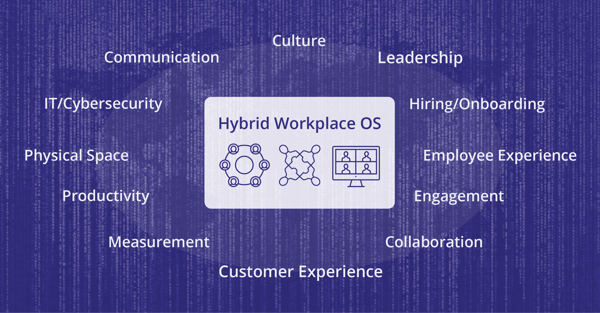Managing Change in Our Re-imagined Workplaces

5 Mins
Updated: September 15, 2022
Published: August 26, 2020

We are at a fascinating, unique time as every one of our organizations faces change in response to and triggered by a global pandemic. The change is at the same time the most individual and collective we have ever experienced. Prosci tackled the challenges in a uniquely Prosci way—by collaborating with our change communities and clients to identify the challenges ahead of us and adaptations we can make to deliver outcomes on today’s most critical changes. The lessons we are learning can help you support your organizations and people through change as we return to the workplace and re-imagine what the workplace of the future will mean.
Learning From Strategic Change Leaders
Need to virtualize your change management practice?
Get the best practices and guidance you need on demand in our premium webinar.
During ACMP Connect, we interacted with hundreds of attendees. And each week we have numerous conversations with changes agents and clients.
1. Safely returning to and operating in the workplace
How difficult will these challenges be? What’s the challenge related to designing, developing and delivering the solutions? Will people embrace, adopt and use the required changes? To answer these questions, it’s helpful to assess both the technical-side and people-side complexities. For example, the technical complexity of acquiring and distributing masks is not significant, but getting people to wear them appropriately to create the work environment we need to keep people safe is a challenge with high people-side complexity. Changes with high people-side complexity require change management.
Once you understand how people must show up differently, you will determine how to support adoption. Conducting a force field analysis with an ADKAR Canvas is an efficient way to do that quickly. Prosci’s ADKAR Quick-Start Guides are also helpful resources, and they're pre-populated with common COVID-19 challenges.
2. Navigating a new hybrid workplace
Perhaps the most surprising aspect of our return to the workplace is that we are now fundamentally redesigning the workplace. Our work engaging with strategic change leaders has revealed that the involuntary digital transformation we all went through has made “place” more arbitrary. Work can be done anywhere. Organizations are now adopting hybrid models where 20% to 60% of work that used to be on premises will stay off premises. We are created hybrid workplaces.
What aspects of your work might be changed because of the pandemic? Meetings, travel, printing and use of paper, real estate footprints, and cybersecurity will all be affected.

Source: Return to the Workplace: Insights From Strategic Change Leaders
What does this mean for culture, leadership, hiring and onboarding? What does this do to the employee experience? Customer expectations and experience will certainly shift. Being thoughtful about how “place” matters is important to understanding what the hybrid workplace will look like for you.

Aspects of the Hybrid Workplace OS
3. Effectively leading change in the hybrid workplace
How will we virtualize the practice of change management in this new, hybrid world? How will practitioners adapt our methodology, tools and engagement approach? We know that sponsors and people managers are the face and voice of change—the two most important groups of actors in a change organization. How do sponsors fulfill the ABCs? How do people managers adapt their CLARC roles? This is uncharted territory. We're just starting our research to build a body of knowledge on this front, in part through collaborating with change practitioners like you.
Given what we know about how human beings change, as well as our discussions with strategic change leaders, we anticipate shifts in these areas:
Responsive change management – adapting and adjusting to changing conditions
Although the future continues to shift and we don’t know what it will look like, there’s a lot we already know about Agile change. To be responsive, we must align change management with iterative initiatives, and build strategies and planning that can flex into changing conditions into our work. Practitioners will need solutions that provide actionable, practical tools for rapid results.
Contingent change management – developing A, B and C change plans
With so much uncertainty, we should intentionally identify alternative change strategies. It's a different world because we don't know what the third or fourth release might look like, as we usually do in an Agile project, but we can become more responsive through contingent plans.
 Regionalized change management – hyper-focusing on localized change management
Regionalized change management – hyper-focusing on localized change management
Because conditions and responses vary and continue to evolve in each locality, the disconnect across geographic boundaries will amplify, especially if you are a global organization. To be successful, we need to tailor messaging, communications, plans and approaches according to the changing needs of each region.
Virtual stakeholder engagement – how we become more effective in our current state of virtual change management work
At Prosci, we began virtualizing our entire training solutions portfolio in March. Through this experience, we learned that creating captivating virtual experiences requires pivoting around purpose, mastering virtual facilitation, creating a virtual engagement language, avoiding boredom and distraction, and embracing what is uniquely virtual.
4. Influencing the strategic change agenda
The fourth area we identified involves empowering senior leaders and people managers to lead in the new reality. After engaging with change practitioners and strategic change leaders from the advisory board and different groups, we realized there are three roles the change practitioner is stepping into right now. The first is influencing the return to the workplace from a more strategic seat, influencing decisions about how to bring our organization physically back together. The second involves applying change management to return-to-the-workplace changes, such as putting arrival procedures and health checks in place. And the third focuses on adapting your change management practice to the new hybrid environment, including those non-return-related changes such as the ERP that had been paused. Change practitioners have a unique opportunity to help their organizations build agility and deliver results in a rapidly changing environment.
Successful Change in a Hybrid World
Although these four areas offer critical insights, discussions are not enough. Strategic investment in change management and organizational capability will deliver the outcomes organizations need right now. Every organization, including yours, will have a set of plays in their playbook for the return-to-workplace changes. Those who understand that success depends not on the plays themselves, but how well we get our people to execute them are the organizations that will triumph.


